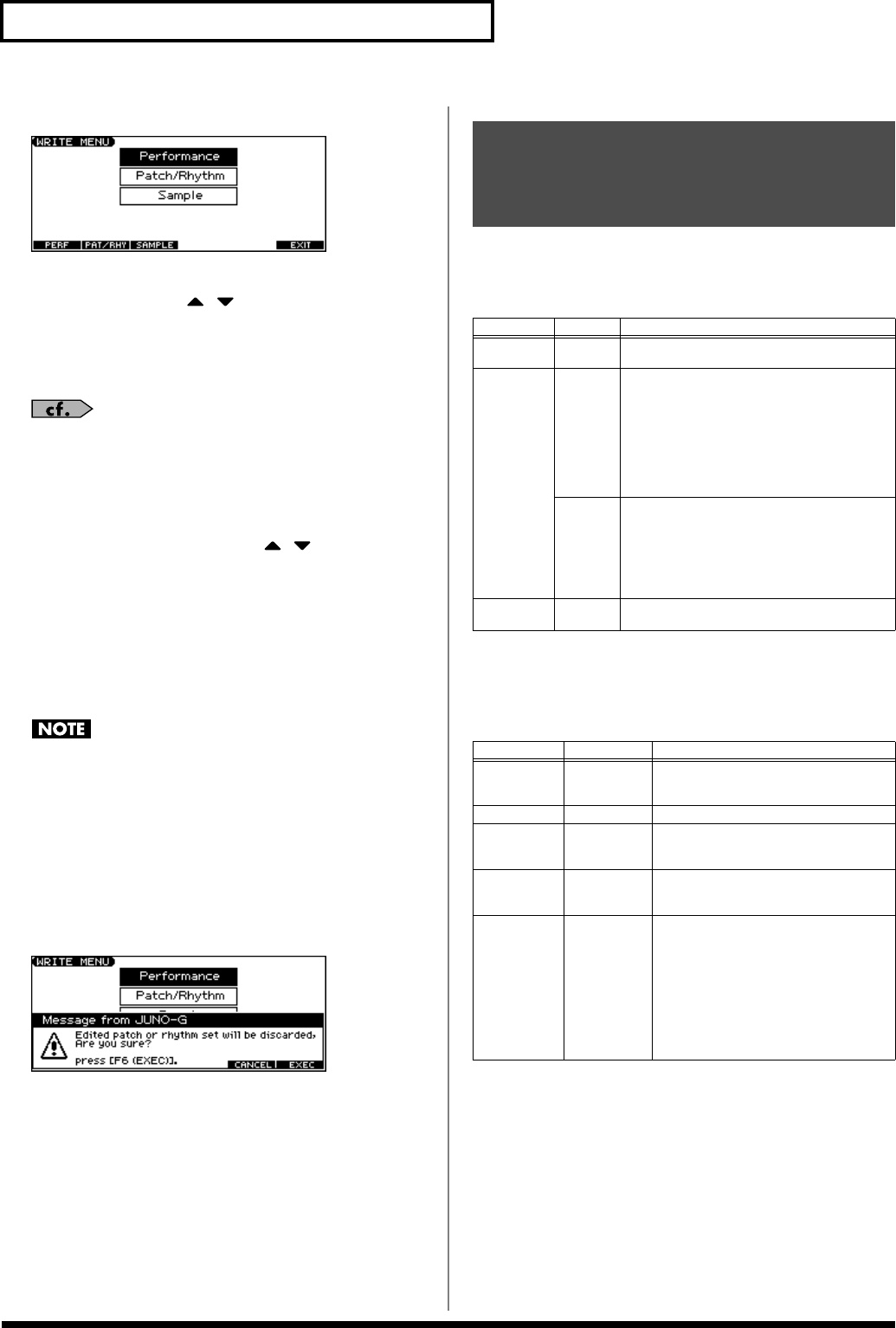
64
Creating a Performance
The WRITE MENU screen appears.
3.
Press [F1 (PERF)].
* Alternatively, you can use [ ] [ ] to select “Performance,” and
then press [ENTER].
The PERFORMANCE NAME screen appears.
4.
Assign a name to the performance.
For details on assigning names, refer to
Assigning a Name
(p. 24).
5.
When you have finished inputting the name, press [F6 (WRITE)].
A screen will appear, allowing you to select the write-
destination performance.
6.
Use the VALUE dial, [INC] [DEC], or [ ] [ ] and [F1 (USER)]
[F2 (CARD)] to select the write destination and rhythm set
number.
7.
Press [F6 (WRITE)].
A message will ask you for confirmation.
8.
Press [F6 (EXEC)] to execute the save operation.
* To cancel, press [F5 (CANCEL)].
Never switch off the JUNO-G while data is being saved.
When Changing the Settings for the
Patch or Rhythm Set Assigned to a
Part in a Performance
If you’ve edited a patch or rhythm set assigned to a part in a
performance and then try to save the performance without first
saving the edited patch or rhythm set, the following message
appears.
In such cases, first save the patches and rhythm sets, and then save
the performance.
[F5 (PART VIEW)]
[F1 (PATCH)]
* When the cursor is at a Type, Group, or Number, you can press
[ENTER] to open the PATCH LIST screen and choose a patch from
the list (p. 27).
[F2 (LVL PAN)]
Functions of Parameters of
Each Part
(Performance Parameters)
Parameter
Value Explanation
Type
Patch,
Rhythm
Sets the assignment of a patch (Patch) or rhythm
set (Rhythm) to each of the parts.
Group USER,
PR-A–F,
GM,
CARD,
USAM,
CSAM,
EXP
Selects the group to which the desired patch be-
longs. (
*
If Type is Patch)
USER:
User
PR-A–F:
Preset A–F
GM:
General MIDI (GM2)
CARD:
Card
USAM:
User Sample
CSAM:
Card Sample
EXP:
Wave Expansion Board
USER,
PRST,
GM,
CARD,
EXP
Selects the group to which the desired rhythm
set belongs. (
*
If Type is Rhythm)
USER:
User
PRST:
Preset
GM:
General MIDI (GM2)
CARD:
Card
EXP:
Wave Expansion Board
Number 001–**** Selects the desired patch or rhythm set by its
number.
Parameter
Value Explanation
Level
0–127 Volume of each part
This setting’s main purpose is to adjust
the volume balance between parts.
Pan L64–0–63R Left/right position of each part
Kbd OFF, ON
(
✔
)
Specifies, for each part, whether or not the
keyboard controller section will be con-
nected to the internal sound generator.
Solo OFF, ON
(
✔
)
Check “
✔
” this setting if you want to hear
the part by itself; this is called “soloing”
the part.
Mute OFF, ON
(
✔
)
Mutes (
✔
) or un-mutes (OFF) each part.
Use this setting when, for example, you
want to use the instrument for karaoke
by muting the part playing the melody,
or when you want to play something
using a separate sound module.
* The Mute Switch parameter does not turn
the part off, but sets the volume to mini-
mum so that no sound is heard. Therefore,
MIDI messages are still received.
JUNO-G_e.book 64 ページ 2006年2月13日 月曜日 午後2時44分


















